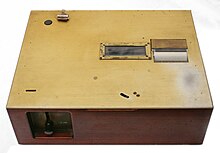
Teaching machines were originally mechanical devices that presented educational materials and taught students. They were first invented by Sidney L. Pressey in the mid-1920s.[1] His machine originally administered multiple-choice questions. The machine could be set so it moved on only when the student got the right answer. Tests showed that learning had taken place.[2][3][4][5] This was an example of how knowledge of results causes learning. Much later, Norman Crowder developed the Pressey idea further.[6][7]
B. F. Skinner was responsible for a different type of machine which used his ideas on how learning should be directed with positive reinforcement.[8] Skinner advocated the use of teaching machines for a broad range of students (e.g., preschool aged to adult) and instructional purposes (e.g., reading and music). The instructional potential of the teaching machine stemmed from several factors: it provided automatic, immediate and regular reinforcement without the use of aversive control; the material presented was coherent, yet varied and novel; the pace of learning could be adjusted to suit the individual. As a result, students were interested, attentive, and learned efficiently by producing the desired behavior, "learning by doing".[9][10]
There is extensive experience that both methods worked well, and so did programmed learning in other forms, such as books.[11] The ideas of teaching machines and programmed learning provided the basis for later ideas such as open learning and computer-assisted instruction.
Illustrations of early teaching machines can be found in the 1960 sourcebook, Teaching Machines and Programmed Learning.[12] An "Autotutor" was demonstrated at the 1964 World's Fair.[13]
- ^ Pressey's priority is supported by Ernest Hilgard, "Programmed learning", in: Hilgard, Ernest R.; Bower, Gordon H. (1966). "Learning and the technology of instruction". Theories of learning. Century psychology series (3rd ed.). New York: Appleton-Century-Crofts. pp. 541–584 (554–561). OCLC 180603.
- ^ Pressey, Sidney L. (20 March 1926). "A simple apparatus which gives tests and scores—and teaches". School & Society. 23 (586): 373–376. ISSN 0036-6455. Reprinted in Lumsdaine & Glaser 1960, pp. 35–41.
- ^ Pressey, Sidney L. (7 May 1927). "A machine for automatic teaching of drill material". School & Society. 25 (645): 549–552. ISSN 0036-6455. Reprinted in Lumsdaine & Glaser 1960, pp. 42–46.
- ^ Pressey, Sidney L. (19 November 1932). "A third and fourth contribution toward the coming 'industrial revolution' in education". School & Society. 36 (934): 668–672. ISSN 0036-6455. Reprinted in Lumsdaine & Glaser 1960, pp. 47–51.
- ^ Pressey, Sidney L. (April 1950). "Development and appraisal of devices providing immediate automatic scoring of objective tests and concomitant self-instruction". The Journal of Psychology. 29 (2): 417–447. doi:10.1080/00223980.1950.9916043.
- ^ Crowder, Norman A. (1959). "Automatic tutoring by means of intrinsic programming". In Galanter, Eugene (ed.). Automatic teaching: the state of the art. New York: Wiley. pp. 109–116. OCLC 705973.
- ^ Crowder, Norman A. (1960). "Automatic tutoring by intrinsic programming". In Lumsdaine, Arthur A.; Glaser, Robert (eds.). Teaching machines and programmed learning I: a source book. Vol. 1. Washington D.C.: Dept. of Audiovisual Instruction, National Education Association of the United States. pp. 286–298. OCLC 12729062.
- ^ Skinner, B. F. (1968). The technology of teaching. The Century psychology series. New York: Appleton-Century-Crofts. OCLC 180158. Includes reprints of all his papers on programmed learning.
- ^ Skinner, B. F. (November 1961). "Teaching machines". Scientific American. 205 (5): 91–102. doi:10.1038/scientificamerican1161-90. JSTOR 24937132. PMID 13913636.
- ^ Holland, James Gordon; Skinner, B. F. (1961). The analysis of behavior: a program for self-instruction. New York: McGraw-Hill. p. 387. OCLC 190451.
- ^ Glaser, Robert, ed. (1965). Teaching machines and programmed learning II: data and directions. Vol. 2. Washington D.C.: Dept. of Audiovisual Instruction, National Education Association of the United States. OCLC 220279103.
- ^ Lumsdaine, Arthur A.; Glaser, Robert, eds. (1960). Teaching machines and programmed learning I: a source book. Vol. 1. Washington D.C.: Dept. of Audiovisual Instruction, National Education Association of the United States. OCLC 12729062.
- ^ "Auto-Tutor (1964)". Paleofuture. Retrieved 2021-08-31.